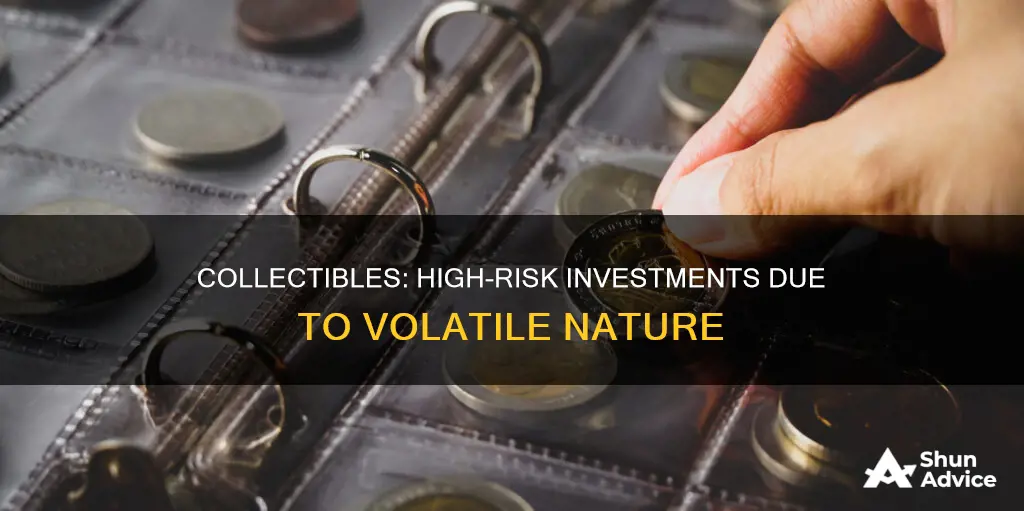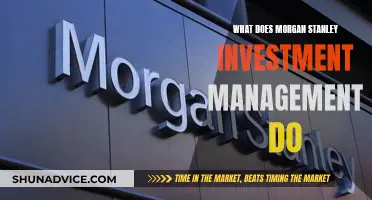
Collectibles are considered a high-risk investment for a number of reasons. Firstly, they are subject to the tastes, moods and perceptions of buyers and sellers, which can be temporary and diminish overnight. There is also a high risk of fraud, fakes and forgeries, and even experts can be fooled by convincing knock-offs. Collectibles dealers are known for marking up items to make a profit, and there is a risk of high costs and fees, as well as a lack of investment income or dividends.
| Characteristics | Values |
|---|---|
| High costs and fees | Maintenance costs, insurance, securing items |
| Lack of investment income or dividends | No intrinsic value |
| Prevalence of counterfeits | Fraud, fakes, forgeries |
| Greater than average risk of destruction of assets | Temporary value |
What You'll Learn

High costs and fees
Investing in collectibles can be an expensive endeavour, with high costs and fees that can quickly add up. One of the main expenses is the cost of the collectible itself, which can be significantly marked up by dealers looking to make a profit. These markups can be difficult to avoid, as the collectibles market is unregulated and subject to the whims of buyers and sellers. This means that prices can be volatile and driven by temporary trends, making it challenging to predict whether an investment will pay off in the long run.
Maintenance costs are another significant factor. Proper insurance, storage, and security measures can all add to the overall expense of owning a collectible. These costs can be ongoing and may increase over time, especially if the collectible requires specialised care or restoration.
Additionally, there is a risk of counterfeits and forgeries in the collectibles market. Dealers and even experts can be fooled by convincing fakes, and authenticating items can be costly and time-consuming. This risk further underscores the importance of due diligence and research before making any investment decisions.
The lack of guaranteed returns or dividends with collectibles also contributes to the high-risk nature of this investment class. Unlike traditional investments such as stocks or bonds, collectibles do not generate income or provide regular profit. There is no intrinsic value to collectibles, and their worth is solely based on the demand and preferences of buyers and sellers. As a result, there is no assurance that you will recoup your initial investment or make a profit when it comes time to sell.
Overall, the high costs and fees associated with collectibles, coupled with the unpredictable nature of the market and the absence of guaranteed returns, make this a high-risk investment choice.
Monthly or Annually: Which Investing Strategy Wins?
You may want to see also

Lack of investment income or dividends
Investing in collectibles is considered high risk due to a lack of investment income or dividends. Unlike traditional investments such as stocks, bonds, mutual funds or cash, collectibles do not provide a regular income stream. They are subject to the fluctuating tastes, moods and perceptions of buyers and sellers, which can be temporary and change overnight. This means that there is no guarantee that you will recoup your initial investment or make a profit when you sell.
The value of collectibles is often based on subjective factors such as rarity, condition, and cultural significance, which can be difficult to predict or control. As a result, the market for collectibles can be highly volatile, and the value of your investment can decrease significantly if the demand for a particular item decreases.
Additionally, collectibles are not immune to the performance of the greater financial markets. A better overall market often leads to a better collectibles market. This means that if the economy is struggling, the value of collectibles may also decrease as people have less disposable income to spend on non-essential items.
Furthermore, collectibles are often high-maintenance investments that require proper insurance and secure storage. The costs of maintaining and insuring collectibles can be significant and may outweigh any potential profits.
Overall, the lack of investment income or dividends associated with collectibles makes them a high-risk investment option. While they can provide excitement and reward for those with a personal interest, there is a significant risk of losing money or failing to generate a return on your investment.
Past Performance: Investment Manager Selection's Holy Grail?
You may want to see also

Risk of counterfeits
Collectibles are considered a high-risk investment due to the prevalence of counterfeits. This is an unregulated industry full of frauds, fakes and forgeries, and even experts can be fooled by convincing knock-offs. The market for collectibles is driven by the tastes, moods and perceptions of buyers and sellers, which are typically temporary and can diminish overnight. As such, there is no guarantee that you will recoup your initial investment or be able to sell your collectible in the future for more than it is currently worth.
The risk of counterfeits is particularly high in the collectibles market due to the lack of regulation and the potential for high profits. Dealers are known to mark up items so they can make a large profit, and this can incentivise the sale of fakes. It is also difficult to authenticate collectibles, especially if they are rare or unique items.
To mitigate the risk of counterfeits, potential collectors should research the market and have a personal interest in the collectibles category they are investing in. This can help to ensure that the item is authentic and that the collector is not paying an inflated price. It is also important to consider the maintenance costs, insurance and security of the items, as these can impact the overall value of the investment.
While the risk of counterfeits is a significant concern in the collectibles market, it is not the only risk factor. The high costs and fees associated with collectibles, as well as the potential for lower returns than other investments, also contribute to the overall riskiness of this asset class. Additionally, collectibles are not immune to the performance of the greater financial markets, and a downturn in the overall market can negatively impact the value of collectibles.
Debt Financing's Impact on Equity Investment
You may want to see also

Risk of destruction
Collectibles are considered a high-risk investment because they are subject to the tastes, moods and perceptions of buyers and sellers, which are typically temporary and can diminish overnight. They have no intrinsic value and there is a greater than average risk of destruction of the assets. There is also zero guarantee that you will recoup your initial investment or that you will be able to sell it in the future for more than it's currently worth.
The market for collectibles is unregulated and full of frauds, fakes and forgeries. Even experts can be fooled by convincing knock-offs. Dealers are also known to mark up items so they can make a profit.
Maintenance costs, the need for proper insurance and securing the items are also things to consider when investing in collectibles. Rare artworks, vintage cars, antique furniture, historical memorabilia and first-edition books are some of the most valuable collectibles.
Social Security Investment Strategies: Maximizing Your Savings
You may want to see also

No intrinsic value
Collectibles are considered a high-risk investment because they have no intrinsic value. Their value is subject to the tastes, moods and perceptions of buyers and sellers, which can be temporary and diminish overnight. This means there is no guarantee that you will recoup your initial investment or that you will be able to sell it in the future for more than it is currently worth.
The market for collectibles is also unregulated and full of frauds, fakes and forgeries. Even experts can be fooled by convincing knock-offs. Dealers are also known for marking up items to make a profit.
There are also high costs and fees associated with collectibles, as well as a lack of investment income or dividends. Collectibles are also not immune to the performance of the greater financial markets, so a downturn could affect their value.
Finally, collectibles are also at a greater risk of destruction than other assets.
Value Investing: Still Relevant or Relic of the Past?
You may want to see also
Frequently asked questions
Collectibles are unregulated, so there is a high risk of fraud, fakes and forgeries. There is also no guarantee that you will recoup your initial investment.
There is a high risk of destruction of assets, and collectibles are not immune to the performance of the greater financial markets.
Rare artworks, vintage cars, antique furniture, historical memorabilia, and first-edition books.
Maintenance costs, the need for proper insurance, and the potential for lower returns than other investments.
Traditional investments like stocks are expected to return income payments or profit, whereas collectibles have no intrinsic value and are subject to the temporary tastes, moods and perceptions of buyers and sellers.







